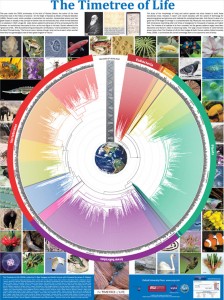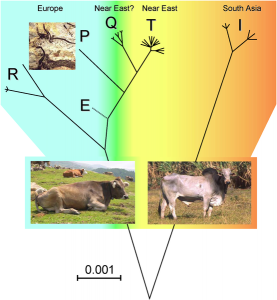- DFID-supported collection of stories showing how information about new ways of doing things is communicated to rural people in developing countries includes some agrobiodiversity stuff.
- The genetic nature of the Pea-comb phenotype in chickens.
- Entomopathogenic fungus can become an endophyte in sorghum and confer protection from stem borer. Ain’t agrobiodiversity grand?
- Different earthworm species have different effects on the competition between four annual plants and their relative fecundity. Ain’t agrobiodiversity grand?
Nibbles: Tameness, Grass evolution, Baobab leaves, Cloning, Svalbard
- The roots of tameness.
- The roots of “grain endosperm texture.”
- The roots of drought tolerance in baobab.
- The roots of the difference between mitosis and meiosis.
- The roots of Svalbard.
When did you last see your common ancestor?
Just came across a truly amazing website called TimeTree. You give it the names of two organisms and it goes away and looks at its database of published literature on molecular clock studies and calculates the time when they diverged.
I put in Oryza sativa and Oryza meridionalis and it returned a figure of 2 million years ago (Mya) based on a recent paper. Asian rice and maize diverged about 36.25 Mya. And Homo sapiens and rice last shared a common ancestor 1,397.06 Mya, in case you were wondering. The sheep and goat diverged about 9 Mya.
So much fun one could have… I hope they put in a lot more crop wild relative data, though.

Aurochs alive and well
Well, not quite. But some of their DNA is. A paper just out in PLoS ONE has found two mitochondrial DNA haplogroups (the ones labelled R and P in the diagram below) which apparently got into Italian local breeds from “European aurochsen [haplogroup E] as the result of sporadic interbreeding events with domestic herds grazing in the wild.” Some of these breeds are rare and marginalized, though, so even the last remnants of the aurochs might be in danger.

Ampelographical errors good and bad
It has recently emerged that some Australian vine growers have been growing Savagnin Blanc (Traminer), an obscure French variety from the Jura, rather than what they thought they had planted, the considerably sexier Spanish grape Albarino. Apparently, CSIRO was sent mis-labelled cuttings by the National Germplasm Collection of Spain, a mistake that was spotted only after DNA work. It’s all explained, with what I suspect is relish, in an article in the New Zealand Herald. 1 Just the latest in a long line of trans-Tasman wine spats.
For the Australian winegrowers that have planted the 150ha currently in production in the country, this discovery is a blow as while there’s demand for albarino, the profile of savagnin – which they must now label wines made from these vines – is considerably lower.
As the article points out, not all such errors in identification are bad news.
Over a decade ago in Chile, another case of confusion proved more fruitful when what the Chileans had previously considered merlot actually turned out to be carmenere. This “lost grape of Bordeaux” was virtually extinct until it was found alive and growing very well among the merlot in Chile. It was a situation that inadvertently preserved the variety and led to the New World wine-producing nation to embrace it as a real point of difference and claim it as its flagship variety.
DNA fingerprinting should put a stop to this, of course. But as there are “5000 wine grape varieties with over 20,000 different monikers,” at least according to the article, it may be a while until cases of vine mistaken identity are things of the past.